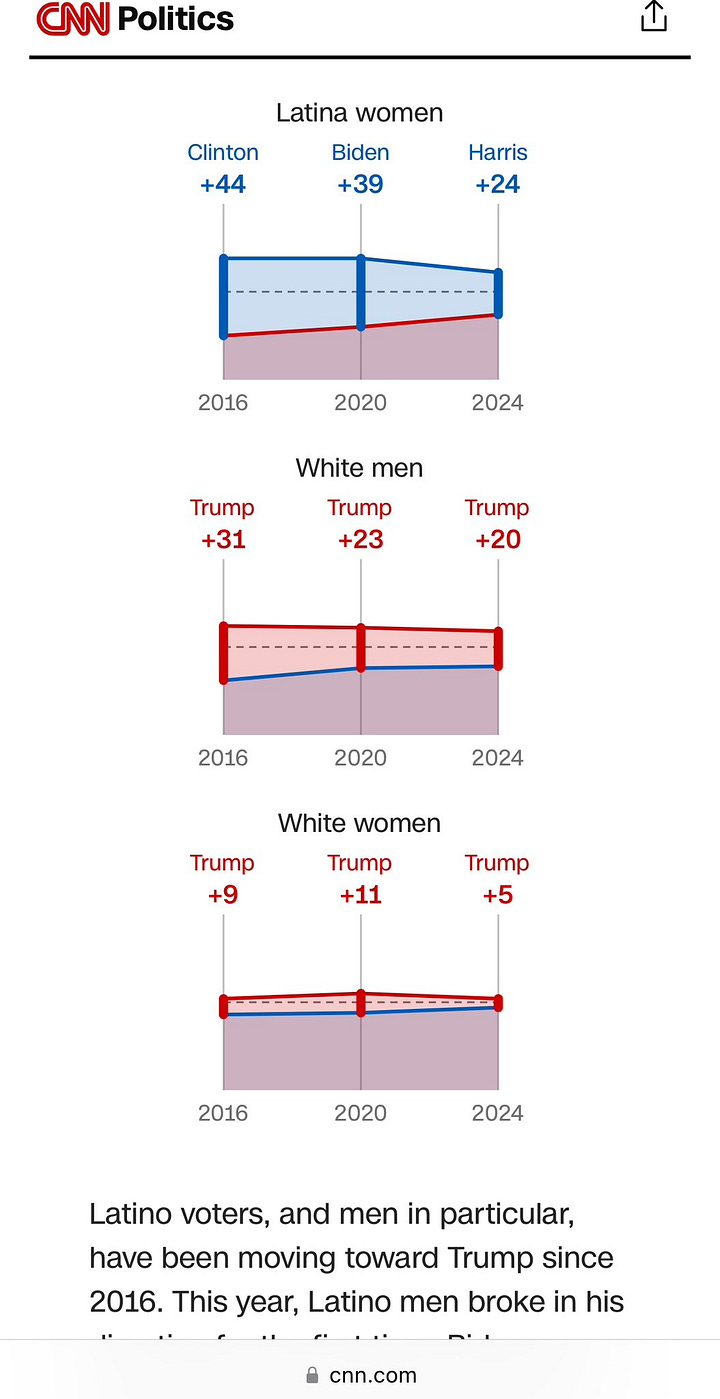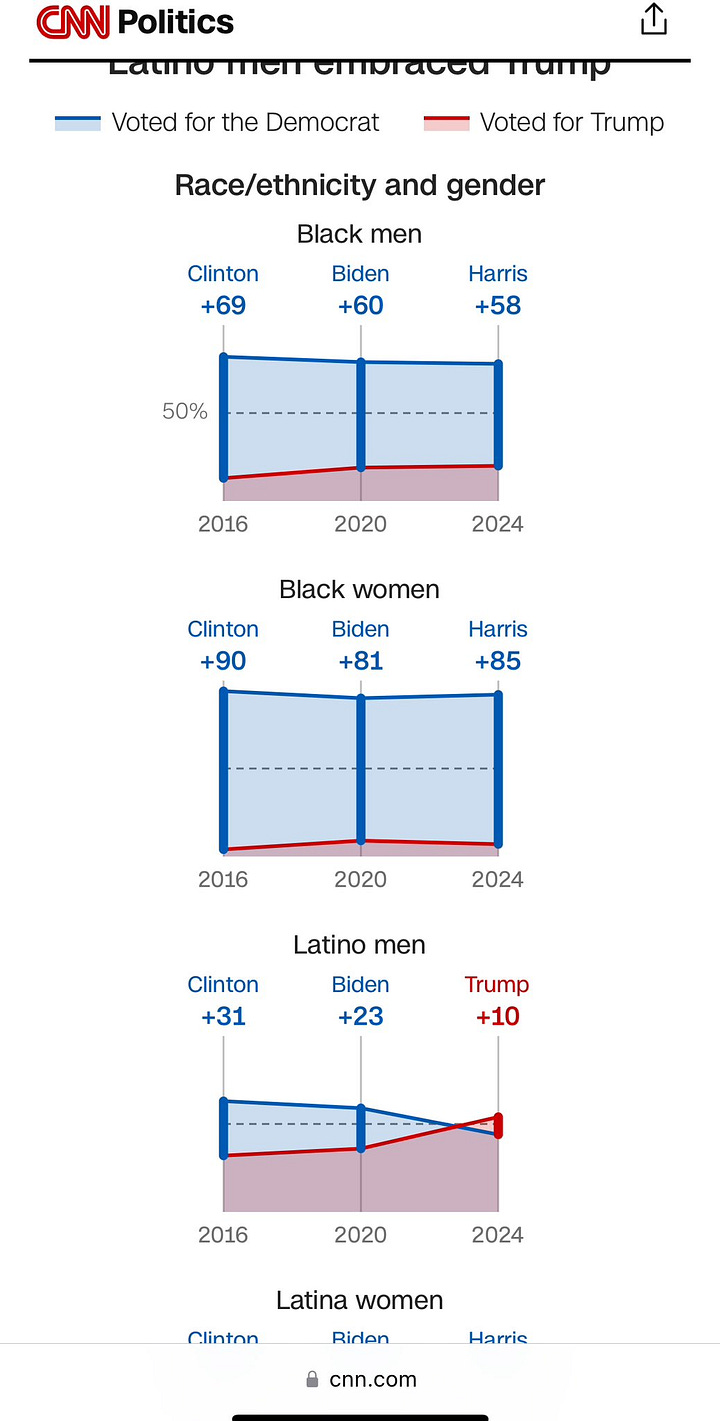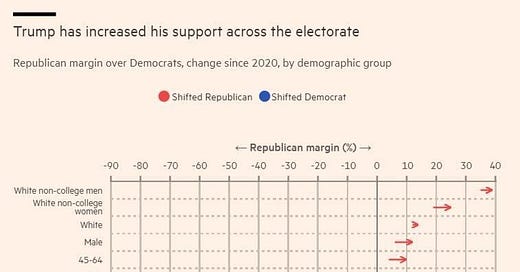Complicating the narrative about "stupid" white women
On the exit polls, and why 2016 post-mortems don't work in 2024
Once again, a majority of white women voted for Donald Trump.
In the years since 2016, much has been made of white women’s support for Trump, a pattern that continued in 2024. As Malcolm Ferguson put it in The New Republic, “52 percent of white American women showed us who they are: Trump supporters.”
Plenty of white women are unhappy about it themselves, and ready to admonish their Trump-voting peers.
On X, one user scolded her “fellow white women. This will fall on deaf ears but IDGAF. You vote against your interests time after time…”
Some are debating amongst themselves whether wearing blue friendship bracelets - a signal of their support for Harris - is helpful or performative.
Another X user wrote, “I struggle with the generalizations of entire demographics but like…fellow white women…are you stupid”
Opinion columnists weighed in with related takes. The LA Times’ LZ Granderson asked what happened to produce another Trump win: “The answer isn’t that deep: The majority of white women in this country want a male president — preferably white.”
In another LA Times piece, news and culture critic Lorraine Ali pins the blame on “Karens,” those avatars of white female privilege, that “certain type of middle- or upper-middle-class white woman who overexerts her privilege in situations she finds to be unfair.”
And who are those Trump-supporting white women?
They’re not, at least not primarily, “middle- or upper-middle-class white woman” - although many did vote for Trump. Rather, it was largely working-class white women who voted for Trump - along with working-class voters from many other groups.
According to exit poll data from CNN, majorities of white voters with college degrees - particularly white college women - not only voted for Harris but actually were one of very few demographics in this election to shift toward the Democrats. As CNN’s analysis noted, Harris did better with college women than Biden or Clinton, winning them by about 15 points.
Across the board, people earning more than $100,000 were more likely to vote for Harris, while those earning less more often supported Trump, per this NBC exit poll data.
Meanwhile, working class voters across a variety of groups shifted toward Trump - most notably Latino voters (driven by Latino men), who voted for Trump in similar numbers to white women overall.
So while white women were essential to Trump’s victory, the trajectory that this election revealed is more complex when it comes to voting patterns and demographics.


And what about those efforts I wrote about to win over white suburban women for Harris? They appear to have worked at least somewhat when it comes to white women who went to college. But working-class women - like many other groups of working-class voters - are another story, a story Democrats are, it seems, now trying to better understand.
Which all points to a new reality many Democrats are somewhat messily grappling with after this election: a loss that simply cannot solely be chalked up to white voters longing for another round of Donald Trump - although that remains no small piece of his success, as it always was. Going forward, Democrats will have to contend with their apparent failure to connect with the working class - a group Democrats have historically seen as one of their key constituencies.
I’m on a reporting trip in Pennsylvania right now, hoping to gain a better understanding of the big shift among Latino voters. More on that in the days to come.
In the meantime:
Here’s a look from the NPR Politics Podcast at how Harris lost the election, with reporting and analysis from my colleagues Deepa Shivaram and Mara Liasson and featuring Yours Truly.
And here’s my analysis of why abortion-rights ballot measures performed well overall on Tuesday night, but concerns about abortion restrictions weren’t enough for voters to give Harris the win.




Working class women do most of the grocery shopping and have been more heavily impacted by high food prices. They unfairly blamed this administration and voted them out. In a few years they will realize their mistake hopefully.
Is misogyny more prevalent among the working class? This would be a great PhD research study as well as learning what works to overcome this unconscious bias in this segment of society. Would especially be interested in how to address the internalized misogyny of working class white women.